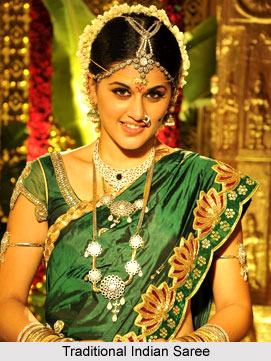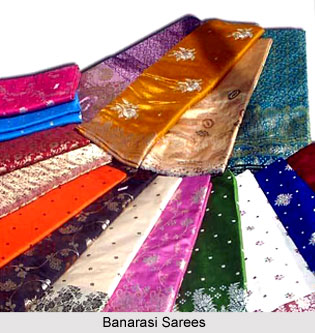 Traditional Indian Sarees speak in volumes about the Indian mass culture and the allied ways of life, the customs, the folk ways and point to the world the tale of a nation that submerges itself into bygone traditions though keeping at par with the ongoing winds of globalization.
Traditional Indian Sarees speak in volumes about the Indian mass culture and the allied ways of life, the customs, the folk ways and point to the world the tale of a nation that submerges itself into bygone traditions though keeping at par with the ongoing winds of globalization.
Jamdani Sarees
Jamdani Sarees are the fine cotton saris of West Bengal which follow the traditional patterns and demonstrate the traditional extravaganza. The Daccai `Jamdani` is essentially a tale of fabric on which the designs are raised in inimitable style and unparallel elegance sums it up. Daccai Jamdani saris distinguished from its mutant cousins by its very fine texture resembling muslin and the elaborate and ornate workmanship.
 Banarasi Saree
Banarasi Saree
Banarasi Saree has the incognito feel of the holy place Banaras. The traditional Banarasi saree is the ideal bridal wear for the Indian brides. This particular saree is a much coveted item for all the Indian women. Being one of the major places of producing silk sarees, Varanasi is the hub of creating Banarasi silk sarees. Traditional till date speaks in volume through this saree.
Indian Silk Sarees
Indian Silk Sarees are a part of the India silk industry which is an integral part of the Indian Textile Industry and therefore the heritage of Indian tradition. This industry is among the oldest industries in India. The Indian silk industry produces basically three types of silks namely Mulburry, Muga, Tussore, and Eri silk. The major hubs of Indian silk industry are located in Karnataka, Andhra Pradesh, Tamil Nadu, Jharkhand, Chhattisgarh, Orissa, Jammu And Kashmir and West Bengal. The traditional sarees like the Banarasi sarees, Kanjeevaram sarees, Konrad sarees, Mysore silk sarees , Pochampally Ikat sarees, Chanderi sarees, Paithani sarees, Patola sarees, Baluchari sarees, Bomkai sarees, Tussar sarees etc are the exclusive creations of the artisans who use silk as the base material for these sarees. Among non-mulberry silks, Tussar is mostly produced by tribal people who are settled in different parts and regions of India. Tussar silk is produced in abundance in India and is the only producer of golden muga silk. Even, India is a major producer of eri silk.
 Gadwal Saree
Gadwal Saree
Gadwal sarees, characteristic of the marvellous textile-crafts of Andhra Pradesh, demonstrate a fine blend of ethnicity and modern designing-concepts. The production site of Gadwal sarees is Gadwal, a small town, situated a distance of 150 km, from Hyderabad, the capital of Andhra Pradesh. Gadwal Sarees were woven in the interlocked-weft technique known as Kupadam. Hence Gadwal`s local name is Kudapam saree.
Sambalpuri Sarees
Sambalpuri Sarees are fresh with the fragrance of Orissa which come in a variety of colours and traditional motifs inspired by nature have gained popularity among people since time immemorial. The sarees come in a variety of designs and colours to suit every taste and more or less each occasion. Sambalpuri sarees are handloom silk sarees made according to the ancient traditional method practiced in Sambalpur in Orissa famous for their unique designs and beautiful, effulgent colors. Sambalpuri cotton sarees have a smooth finish and have a distinctly original border and pallu. Fish, conch shell and flower motifs are woven into the fabric. Sometimes floral and animal motifs are also used to decorate the borders and pallu. They have their own coarse beauty and are often imbued with hidden symbolism. Sambalpuri sarees with motifs, and tie and dye art reflecting superb craftsmanship of the villagers.
 Paithani sarees
Paithani sarees
Paithani sarees derives its name from the village Paithan in Aurangabad district. Paithani saris are worn by the women of Central India on special occasions. There is a glorious tradition which speaks as much for cultivated taste as for the weavers imagination and skill.
Bandhani Sarees
Bandhani Sarees are created by the artisans and about nine totally different social groups are involved with the production of traditional Bandhani textiles in Rajasthan and Gujarat. Bandhani sarees and odhnis are worn by women of all religions, castes and tribes, and are made of cotton, mulberry silk, and even wool in the case of some ethnic odhnis. In recent times, different ethnic and tribal groups still wear odhnis with specific colours and designs. The traditional Bandhani sarees are traditionally worn by wealthier, often urban, women for special occasions, including weddings.
Gharchola Sarees
Gharchola Sarees thrive to be the traditional and most famous type of Gujarati saree called the Gharchola is admired in the West India for its ethnic look. Sarees of different colours are traditionally associated with different festivals. Dark blue and pink cloths are worn and given for Diwali, while Gharchola and panetar-like sarees with green grounds are still given for Raksha Bandhan.
Indian sarees engage a chimera of Indo authentic look by incorporating the traditional techniques of manufacturing saree as well as including different cultural influences.





















